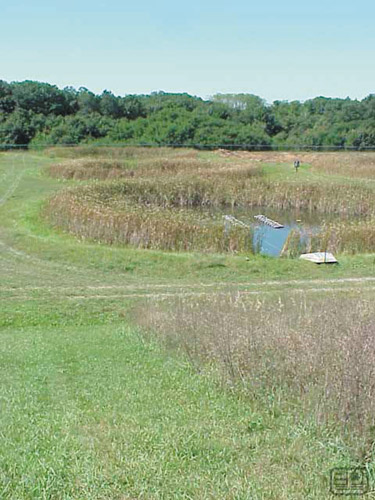PVC Liners Pass the Test |
||
 Research ponds at W.K. Kellogg Biological Research Station lined with 20 mil PVC geomembrane. About KBS Kellogg established, and later donated to Michigan State College, several important facilities that became part of what is now Michigan State University’s Kellogg Biological Station (KBS). KBS is Michigan State University’s largest off-campus education complex and one of North America’s premier inland field stations. The Station is administered through the College of Agriculture and Natural Resources and the College of Natural Science. The KBS Experimental Ponds Each experimental pond was approximately 100 foot in diameter with a maximum depth of 8 feet, with slopes of three horizontal to one vertical, and was lined with 20 mil fish grade PVC geomembrane liner to prevent seepage losses. The liners in the original 18 ponds were covered with 1 foot of compacted soil. After construction, the ponds were allowed to colonize naturally with flora and fauna from surrounding lakes, and within a few years the experimental ponds closely resembled natural systems. These conditions provided the opportunity to conduct a number of significant experiments in the late 1970’s and early 1980’s on species interactions and habitat selection in fishes. However, by the mid-1980’s, the ponds had become choked with dense, persistent stands of macrophytes (predominantly Ceratophyllum). These conditions made many types of experiments impossible. In 1987, a grant from the NSF program for Field Stations and Marine Laboratories funded the renovation of 9 of the original 18 ponds. In these nine ponds, the organic rich sediments and plastic liners were removed. New 20 mil PVC liners were then installed and were covered with a mixture of sand and clay (1 foot depth). This sand/clay substrate was nutrient poor compared to the original topsoil. These renovations successfully returned the ponds to a less eutrophic state. Currently, Chara is the dominant vegetation cover in the renovated ponds (as it is in most nearby lakes), along with Potomogeton spp in the deeper water areas and Typha around the pond perimeters. The remaining original 9 ponds were renovated in a similar manner in late summer 2000, again with support from the NSF and MSU. The PVC Test
Two samples were tested from each of these locations on 09/14/2000. All samples removed from the pond felt very soft and flexible during the removal process. Material removed from the bottom of the pond was softer to the hand than the material from above the water line. Once samples were dried off, the samples felt somewhat less flexible. All samples were tested at the EPI lab in the days following removal from the ponds. Materials were transported in large plastic bags, sealed to minimize moisture loss prior to testing.
Two samples were tested from each location without any preparation, other than removal of any sand or dirt from the material. Two additional samples from each location were cleaned and allowed to acclimate in the lab for 40 hours according to standard ASTM test methods. Samples from each location were tested in both the Machine (MD) and Transverse (TD) direction. After being buried for 30 years, the 20 mil PVC geomembrane has retained its plasticizer and its flexibility, enabling it to perform its function without fail. It has retained its strength and has not deteriorated. It has also resisted puncture by roots, biological attack from microorganisms, and has had no detrimental effect on the environment that it has protected since 1971. The potential for root penetration was a big question in the forensic study of these ponds. Each of the ponds had a large amount of cattails around the perimeter of the pond. As the bulldozer removed the dirt from the top of the liner under the cattail area, careful observation was made of the root zone of the cattails. These cattails produced one root stalk about 3/4” to 1-1/4” in diameter, with a mass of smaller roots around the main root. The root length was approximately 1 to 3 foot. All roots of the cattails grew down to the liner, then grew horizontally along the top surface of the liner. No evidence of liner intrusion was found. One of the ponds that samples were removed from had a small willow tree (12-15 feet tall) growing below the anchor trench but above the water level. The willow tree was located approximately 5 feet down the slope from the anchor trench and had a trunk of 6-8 inches diameter.
As the bulldozer operator cleared the dirt from the sides of the tree, it was observed that the tree roots grew similarly to the cattail roots. They grew down to the liner, then turned and traveled along the surface of the liner. Main roots were 3-5 feet long, with some smaller roots up to 7 feet from the trunk. When the dozer pushed the tree, it slid down the liner to the bottom of the pond, leaving the liner intact. No damage was found from roots penetrating the liner. In the center of each pond was an inlet/outlet structure. This concrete slab was approximately 2.5’ x 2.5 feet, with the top level with the liner sub grade. The liner was placed over the concrete, sealed with mastic, and fastened to the concrete using 2x4” redwood batten strips and concrete nails. This structure and the batten appeared to perform well over the thirty years as indicated by no discoloration of the soil color under the liner and around the structure. To learn more about the experimental ponds and research opportunities available, visit the Michigan State Univeristy web site for the W.K. Kellogg Biological Station at www.kbs.msu.edu/. L&W For more information, contact Fred P. Rohe, Environmental Protection Inc., 9939 US-131 South, Mancelona, MI 49659, (800)OK-LINER, fax (231)587-8020, www.geomembrane.com, pvcliner@geomembrane.com. |
©2002, 2001, 2000, 1999, 1998 Land and Water, Inc.